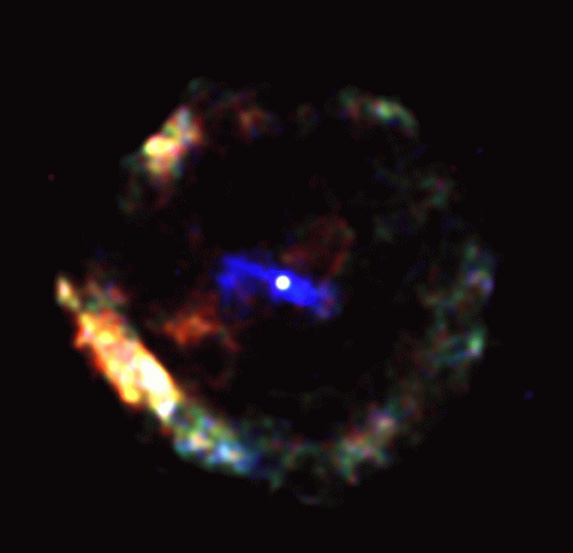
 Credit: NASA/McGill/V. Kaspi et al
Credit: NASA/McGill/V. Kaspi et al
Supernova Bullseye
Exploding stars called supernovae are among the most violent galactic
events. Stars which explode as supernovae are torn apart - their outer
parts get blown outward into the galaxy (and form beautiful nebulae called
supernova remnants), while their cores remain behind as incredibly dense
objects called neutron stars or black holes. Though such explosions are
extremely violent (one supernova can outshine the other billions of stars
in a galaxy), they occur rather frequently, about once or twice per century
in a given galaxy. Eight supernovae have been reported by astronomers over
the last two millenia. By studying these "historical supernovae"
astronomers can study the evolution of the expelled gas and the collapsed
stellar core from the time of the explosion. In 1997 a group of Japanese
astronomers led by Dr. Ken-íchi Torii, using the ASCA X-ray observatory, discovered X-ray
pulsations from an object in a supernova remnant called G11.2-0.3, thought
to have been produced by a stellar explosion reported by Chinese
astronomers in AD 386. The X-ray pulses are thought to be produced by the
rotating neutron star (a pulsar) which is actually the collapsed core of
the exploded star. However this pulsar seemed to be rotating too slowly -
from the observed slowing of the neutron star's spin, astronomers estimated
that the neutron star was formed over 24000 years ago. But, if the neutron
star is really so old, then it would have no physical connection to the
supernova which occurred in AD 386. However, new evidence of a physical
connection between the neutron star and the AD 386 supernova has just been
provided by the Chandra X-ray
observatory. The image of
G11.2-0.3 above was obtained by Dr. Vicki Kaspi and colleagues using
Chandra's ACIS
camera. Chandra's exquisite spatial resolution was able to show that the
pulsar (the bright white spot in the middle of the image) is at the exact
center of the supernova remnant (which appears as the multicolored,
circular shell around the pulsar). Since pulsars move through space, this
shows that the pulsar has not moved appreciably from the place where it
formed, consistent with an age of only 1600 years. Thus, taken together,
the ASCA and Chandra results suggest that pulsars form with a much wider
range of initial rotation periods than astronomers previously believed.
Last Week *
HEA Dictionary * Archive
* Search HEAPOW
* Education
Each week the HEASARC
brings you new, exciting and beautiful images from X-ray and Gamma ray
astronomy. Check back each week and be sure to check out the HEAPOW archive!
Page Author: Dr. Michael F.
Corcoran
Last modified January 22, 2001


